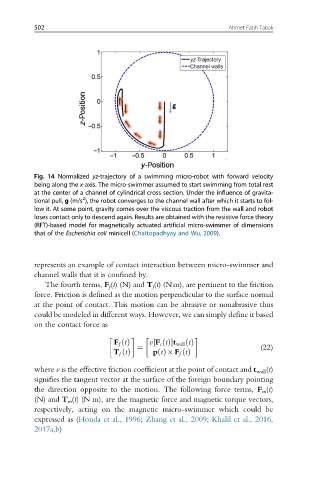Page 508 - Handbook of Biomechatronics
P. 508
502 Ahmet Fatih Tabak
Fig. 14 Normalized yz-trajectory of a swimming micro-robot with forward velocity
being along the x-axis. The micro-swimmer assumed to start swimming from total rest
at the center of a channel of cylindrical cross section. Under the influence of gravita-
2
tional pull, g (m/s ), the robot converges to the channel wall after which it starts to fol-
low it. At some point, gravity comes over the viscous traction from the wall and robot
loses contact only to descend again. Results are obtained with the resistive force theory
(RFT)-based model for magnetically actuated artificial micro-swimmer of dimensions
that of the Escherichia coli minicell (Chattopadhyay and Wu, 2009).
represents an example of contact interaction between micro-swimmer and
channel walls that it is confined by.
The fourth terms, F f (t) (N) and T f (t) (Nm), are pertinent to the friction
force. Friction is defined as the motion perpendicular to the surface normal
at the point of contact. This motion can be abrasive or nonabrasive thus
could be modeled in different ways. However, we can simply define it based
on the contact force as
F f tðÞ v F c tðÞjt wall tðÞ
j
¼ (22)
T f tðÞ p tðÞ F f tðÞ
where v is the effective friction coefficient at the point of contact and t wall (t)
signifies the tangent vector at the surface of the foreign boundary pointing
the direction opposite to the motion. The following force terms, F m (t)
(N) and T m (t) (N m), are the magnetic force and magnetic torque vectors,
respectively, acting on the magnetic micro-swimmer which could be
expressed as (Honda et al., 1996; Zhang et al., 2009; Khalil et al., 2016,
2017a,b)

